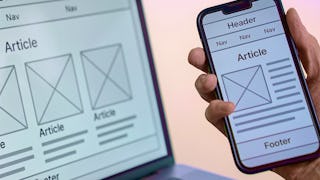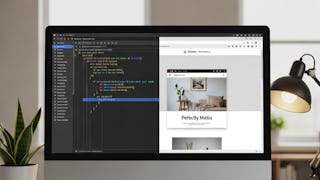It used to be the case that everyone viewed web pages on about the same size screen - a desktop computer. But now it is just as likely that someone will be using a smart phone, tablet, or assistive technology to access the Internet. Therefore, people viewing your site will now expect that it will perform regardless of the device (smartphone, tablet, laptop, desktop computer, or screen reader) AND take into account some common personal settings such as color schemes. This ability to respond to any platform and user preferences is called Responsive Design.


Advanced Styling with Responsive Design
This course is part of Web Design for Everybody: Basics of Web Development & Coding Specialization


Instructors: Colleen van Lent, Ph.D.
134,925 already enrolled
Included with
(4,591 reviews)
What you'll learn
Describe basic knowledge of browser tools for responsive design.
Understand the importance of a "mobile-first" paradigm for web design.
Write rules for responsive design for a mobile and large-screen view.
Skills you'll gain
Details to know

Add to your LinkedIn profile
4 assignments
See how employees at top companies are mastering in-demand skills

Build your subject-matter expertise
- Learn new concepts from industry experts
- Gain a foundational understanding of a subject or tool
- Develop job-relevant skills with hands-on projects
- Earn a shareable career certificate

There are 4 modules in this course
What does it mean to have responsive design for your site? How can you tell if your existing site is responsive? This week we will begin with the theories behind the "mobile-first paradigm" - the idea that your mobile site should provide everything needed, not a pared-down version of a good page. We end the week by taking the first concrete step of using fluid measurements in your CSS.
What's included
6 videos9 readings1 assignment3 discussion prompts
This week you will get a chance to put the theories into practice using media queries in your CSS. These queries can automatically change the look and functionality of your site based on the size of the browser being used to view the page. This allows you to decide what type of look you want to achieve at various screen sizes, also called "viewports".
What's included
7 videos4 readings2 assignments1 peer review1 app item
Knowing what your want your site to look like is the first step, but actually writing the code is another. This week we look at the grid and flex display properties to suggest ways to organize the layout of your page. We also talk about media queries that you should be including to increase the accessibility of your page. These queries can react to user preferences about color schemes, animation, and more.
What's included
5 videos5 readings
After every good programmer has put in time creating sites from scratch, it is common to utilize existing tools out there. After all, why recreate the wheel? The work you have done up to this point will give you the knowledge needed to craft your own unique sites from these frameworks. This week we will work with Bootstrap, a framework that uses HTML5, CSS, and JavaScript (but don't worry if you have never used JavaScript yourself).
What's included
10 videos5 readings1 assignment1 peer review1 app item
Earn a career certificate
Add this credential to your LinkedIn profile, resume, or CV. Share it on social media and in your performance review.
Instructors

Offered by
Explore more from Mobile and Web Development
 Status: Free Trial
Status: Free TrialUniversity of Washington
 Status: Free Trial
Status: Free Trial Status: Free Trial
Status: Free TrialBoard Infinity
 Status: Free Trial
Status: Free Trial
Why people choose Coursera for their career




Learner reviews
4,591 reviews
- 5 stars
78.69%
- 4 stars
16.85%
- 3 stars
3.44%
- 2 stars
0.74%
- 1 star
0.26%
Showing 3 of 4591
Reviewed on Mar 20, 2020
Firstly i thank you all to this good material , and i give my appreciate and thanks to Ph,Dr. Colleen van Lent. And its very useful to me to learn this course .Thank you very much <3
Reviewed on Jan 12, 2017
The course is quite good and intriguing for it offers challenges which are interesting at the same time. Always good to take up a challenge, oh what an experience
Reviewed on Sep 5, 2020
At first I was not good in designing or responsive designing but after learning about bootstrap from this course I am pretty much confident that I can easily design a website

Open new doors with Coursera Plus
Unlimited access to 10,000+ world-class courses, hands-on projects, and job-ready certificate programs - all included in your subscription
Advance your career with an online degree
Earn a degree from world-class universities - 100% online
Join over 3,400 global companies that choose Coursera for Business
Upskill your employees to excel in the digital economy
Frequently asked questions
To access the course materials, assignments and to earn a Certificate, you will need to purchase the Certificate experience when you enroll in a course. You can try a Free Trial instead, or apply for Financial Aid. The course may offer 'Full Course, No Certificate' instead. This option lets you see all course materials, submit required assessments, and get a final grade. This also means that you will not be able to purchase a Certificate experience.
When you enroll in the course, you get access to all of the courses in the Specialization, and you earn a certificate when you complete the work. Your electronic Certificate will be added to your Accomplishments page - from there, you can print your Certificate or add it to your LinkedIn profile.
Yes. In select learning programs, you can apply for financial aid or a scholarship if you can’t afford the enrollment fee. If fin aid or scholarship is available for your learning program selection, you’ll find a link to apply on the description page.
More questions
Financial aid available,

